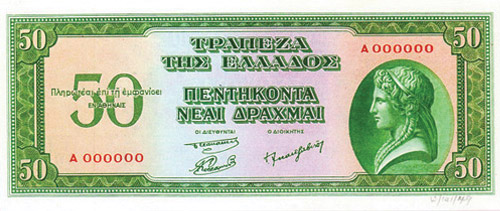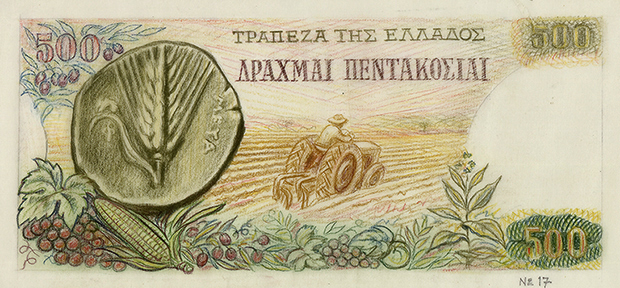Welcome to Greekbanknotes.com
Greek banknotes have a history of 180 years, starting from 1822 and finishing in 2002 when drachma was replaced by the common European currency, Euro. During these years about 300 different banknotes were issued or circulated in Greece and if you count the varieties, the total number reaches the 400.
Notes:

Banknote of 1912 issued by the NBG
Notes were issued by the National Bank of Greece from 1841 until 1928, when the Bank of Greece was created. Early denominations ranged from 10 to 500 drachmae. Smaller denominations (1, 2, 3 and 5 drachmae) were issued from 1885, with the first 5-drachma notes being made by cutting 10-drachma notes in half. Between 1917 and 1920, the Greek government issued paper money in denominations of 10 lepta, 50 lepta, 1 drachma, 2 drachmae, and 5 drachmae. The National Bank of Greece introduced 1000-drachma notes in 1901, and the Bank of Greece introduced 5000-drachma notes in 1928. The Greek government again issued notes between 1940 and 1944, in denominations ranging from 50 lepta to 20 drachmae.
During the German-Italian occupation of Greece from 1941 to 1944, catastrophic hyperinflation and Nazi looting of the Greek treasury caused much higher denominations to be issued, culminating in 100,000,000,000-drachma notes in 1944.

Second modern drachma
In November 1944, after Greece was liberated from Germany, old drachmae were exchanged for new ones at the rate of 50,000,000,000 to 1. Only paper money was issued. The government issued notes of 1, 5, 10 and 20 drachmae, with the Bank of Greece issuing 50-, 100-, 500-, 1000-, 5000-, and 10,000-drachma notes. This drachma also suffered from high inflation. The government later issued 100-, 500-, and 1000-drachma notes, and the Bank of Greece issued 20,000-and 50,000-drachma notes.
Third modern drachma
In 1953, in an effort to halt inflation, Greece joined the Bretton Woods system. In 1954, the drachma was revalued at a rate of 1000 to 1. The new currency was pegged at 30 drachmae = 1 United States dollar. In 1973, the Bretton Woods System was abolished; over the next 25 years the official exchange rate gradually declined, reaching 400 drachmae to 1 U. S. dollar. On 1 January 2002, the Greek drachma was officially replaced as the circulating currency by the euro, and it has not been legal tender since 1 March 2002.




